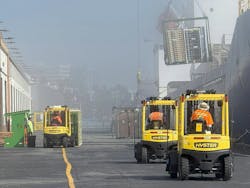SSA Marine Switches all 44 Forklifts to Battery-Electric at LA Port Berth
Port terminal operator SSA Marine has completely transitioned all of its forklift fleet to battery electric propulsion at its Port of Los Angeles berth for moving fruit imports.
The move from propane-fueled to battery-powered includes 44 small and heavy-duty forklifts, the company reported. SSA Marine’s Berth 55 is the first of its terminals to complete this transformation, although similar projects are underway at other ports.
“Achieving this sustainability milestone at Berth 55 reinforces SSA Marine’s commitment to environmental responsibility, operational efficiency, and innovation, not just in breakbulk, but across our operations,” said Meghan Weinman, vice president of sustainability at SSA Marine, in a company statement. “We are proud to partner with the Port of Los Angeles on this ambitious project and we’re confident that Berth 55 will serve as a blueprint for future initiatives.”
Berth 55 at the Port of Los Angeles is an international fruit terminal which SSA Marine has operated since the 1980s. The new battery-electric fleet is made up of 12 10,000-lb Hyster forklifts and 32 3,000-lb Hysters.
The company estimates port fleet electrification will reduce tailpipe CO2 emissions by about 264 metric tons annually. SSA Marine and the Port of Los Angeles have been working on the project for three years.
“SSA Marine has been a longtime tenant at the Port of Los Angeles and their work facilitating the arrival of fruits from South America during our winter months is very important for Southern California and the region,” said Michael DiBernardo, deputy executive director of the Port of Los Angeles. “Our goal for the Port of Los Angeles is to be emissions free with our yard equipment by 2030 and, as a result of this initiative, SSA Marine has completed that goal five years ahead of schedule, which we appreciate.”
Last year, SSA Marine began electrification at its Port of San Diego terminal by putting a Wiggins Yard eBull battery-electric forklift into operation. This was the first of six planned equipment changes the company was making at the Tenth Avenue Marine Terminal.
Propane-fueled forklifts also are seen as decarbonizing steps for warehouse and manufacturing plant equipment compared to diesel models. The Propane Education and Research Council estimates that propane forklifts reduce sulfur oxide emissions 76% and nitrogen oxide emissions 94% compared to diesel vehicles.
About the Author
EnergyTech Staff
Rod Walton is senior editor for EnergyTech.com. He has spent 17 years covering the energy industry as a newspaper and trade journalist.
Walton formerly was energy writer and business editor at the Tulsa World. Later, he spent six years covering the electricity power sector for Pennwell and Clarion Events. He joined Endeavor and EnergyTech in November 2021.
He can be reached at [email protected].
EnergyTech is focused on the mission critical and large-scale energy users and their sustainability and resiliency goals. These include the commercial and industrial sectors, as well as the military, universities, data centers and microgrids.
Many large-scale energy users such as Fortune 500 companies, and mission-critical users such as military bases, universities, healthcare facilities, public safety and data centers, shifting their energy priorities to reach net-zero carbon goals within the coming decades. These include plans for renewable energy power purchase agreements, but also on-site resiliency projects such as microgrids, combined heat and power, rooftop solar, energy storage, digitalization and building efficiency upgrades.
